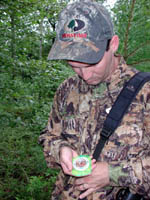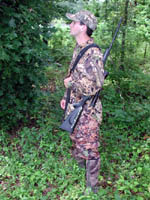
|
Features
|
|
|
|
Books
|
|
|
|
Fun & Games
|
|
|
|
Contact Us
|
|
|
John's Journal... Entry 221, Day 1
STEPS FOR FINDING DOWNED WHITETAILS
Look and Listen
 Editor's
Note: Often your hunt really begins once you've shot or arrowed a deer.
Merely inflicting a mortal wound on a whitetail doesn't finish the hunt.
Only after you've recovered the animal can you call your hunt a success.
Let's look at the steps that will help you locate your downed whitetail.
Editor's
Note: Often your hunt really begins once you've shot or arrowed a deer.
Merely inflicting a mortal wound on a whitetail doesn't finish the hunt.
Only after you've recovered the animal can you call your hunt a success.
Let's look at the steps that will help you locate your downed whitetail.
As soon as you squeeze the trigger on your bow or rifle, watch the
reaction of the deer, especially its tail. Does the deer hold its
tail up, out or down? You may have missed the deer if you see a raised
tail. If the deer's tail points out, you more than likely have hit
the deer. A deer with a tucked tail usually means you have a good
hit. However, none of these signs will guarantee you'll take home
your trophy. Always follow up on every shot. Also ask yourself if
the deer has staggered after the shot, dropped down, jumped up, paused
or walked away. What attitude has the deer had after the shot? Often
the deer's body language will provide you with a good indication of
how well you've hit him. After watching the deer for as far as you
can see him go, pick out a landmark that you can find at ground level
where you've last spotted the deer.
 If
you don't see the deer go down, listen to see if you can hear the
deer stumble and fall. Often you can hear a deer fall when you can't
see it. Try to determine exactly from where you think the sound has
originated. Listen to hear any other sounds that may indicate the
movement of the deer.
If
you don't see the deer go down, listen to see if you can hear the
deer stumble and fall. Often you can hear a deer fall when you can't
see it. Try to determine exactly from where you think the sound has
originated. Listen to hear any other sounds that may indicate the
movement of the deer.
TOMORROW: WAIT AND GET A BEARING
Check back each day this week for more
about STEPS FOR FINDING DOWNED
WHITETAILS ...
Day 1 - Look and Listen
Day 2 - Wait and Get a Bearing
Day 3 - Carefully Analyze What Your Deer
Has Done
Day 4 - Go Slow and Look Up
Day 5 - Know What To Do and Employ a Keener
Nose